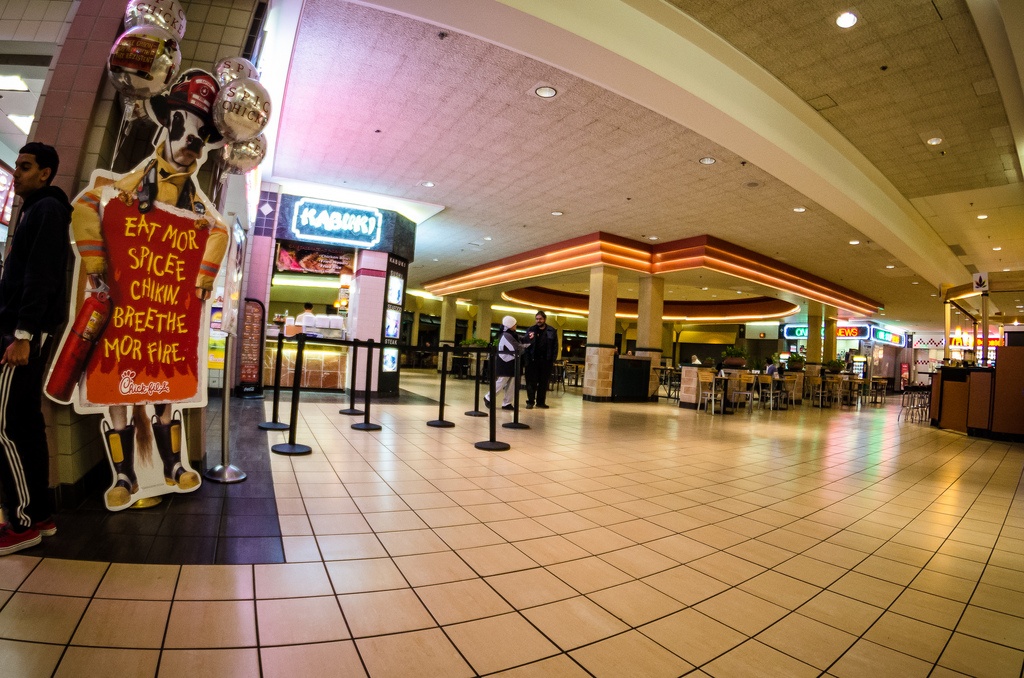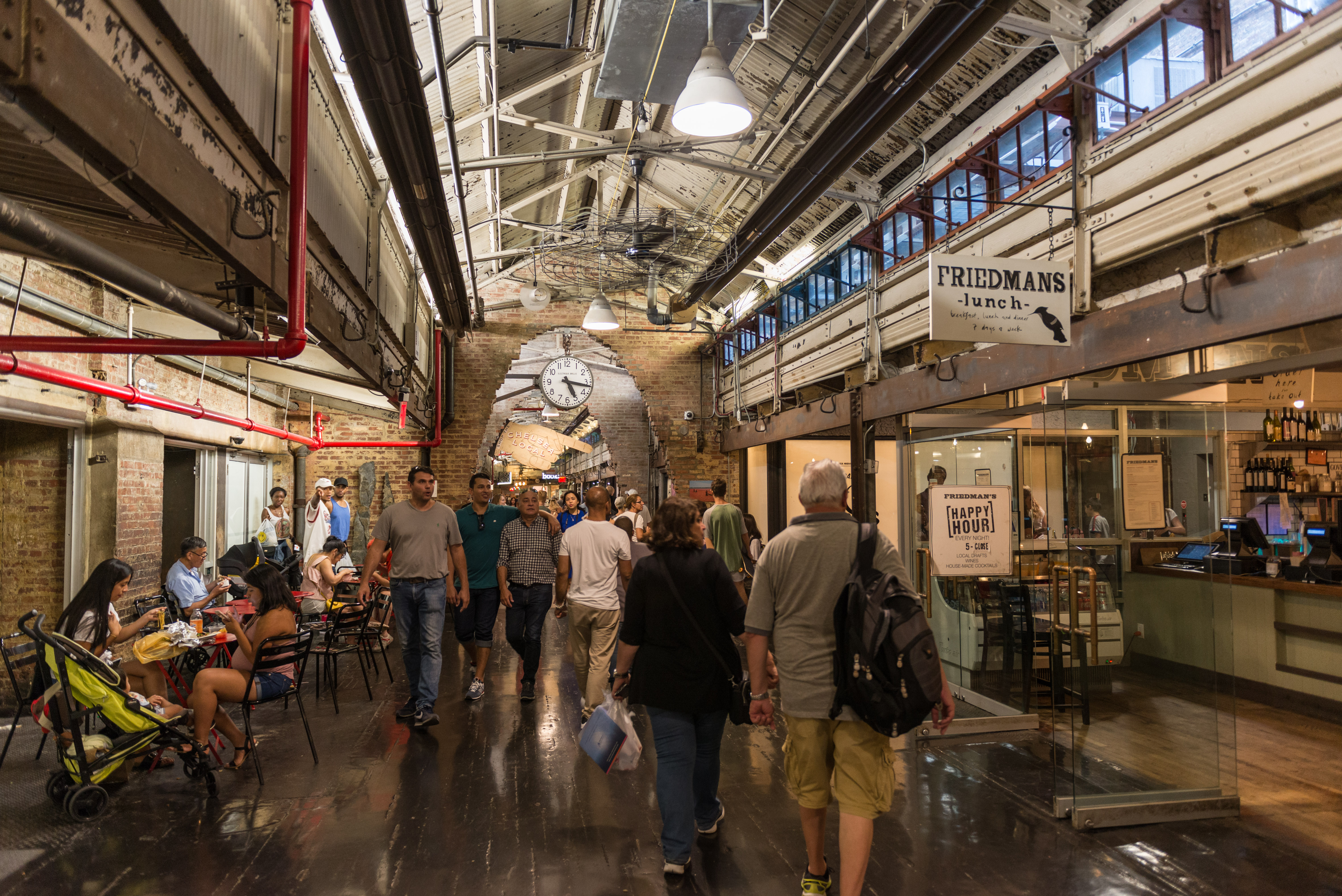Food halls are really becoming a thing now. Once restricted to the nation’s coasts (yes, Chicago counts as a coastal city in this formulation), the concept is now expanding as it is integrated into malls across the country. One retail real estate firm, for example, has disclosed that only 25% of its future deals with tenants will be for apparel compared with more than 50% in 2015. Food is expected to account for about 22% of deals moving forward, up from 11%.
Obviously, developers believe they are on to something; research director Garrick Brown sees a combination of magic bullet and panacea in food halls—the answer to malls’ current woes: “Food halls are about so much more than just real estate. No other retail category has generated as much aggressive expansion over the past few years as food-related retail.” He went on to note that since food halls offer “a definitive experience” they are “largely e-commerce proof,” an experiential Kevlar vest protecting malls from the onslaught of digital commerce.
But can the food hall answer the call and save the mall? Well, that depends. Follow us through the retail and food industry market research as we go deep on the promises and limitations of this potential mall savior.
Hungry for Increased Foot Traffic
The days of teens hanging out at the mall to browse Forever 21 and the Wet Seal are long gone, and it seems their mothers aren’t hanging out at the malls as much either—they’re sitting on the couch, shopping on their Nordstrom App. And that’s fine for Nordstrom but far more troublesome for other mall tenants who rely on big department stores to draw mall traffic, and for the landlords who need to maintain/increase their occupancy rate.
Well, good news for them: teenagers, according to a recent report, are more interested in spending their parents’ money in a restaurant than in a department store. This news helps explain why the excitement around food halls and malls has only increased. What if those teens could be drawn into a mall to eat, and then perhaps even linger around the department stores?
Thus, one retail real estate analyst believes food halls are the cheese in the retail mousetrap, ready to lure in millennials and their disposable income: “What we are hearing from millennials is they want authentic dining experiences. There’s a direct parallel between the quality of food and time spent in a mall.”
Even more exciting, if a recent JJL study is to be believed, it’s not just the teens being driven by food and entertainment. Indeed, 40% of today’s mall patrons are there explicitly to dine. Even more encouraging, those who dine in the mall will spend an average of 35 minutes browsing retailers before or after their meal, generating 12% more sales than those did not dine.
Trafficking in Experiences
Ok, so what does a food hall look like? In their previous iterations as food courts, mall dining options have left much to be desired. Recall, if you will, food courts of years past: Sbarro, Cinnabon, maybe a Hot Dog on a Stick—not the healthiest, freshest, most distinct, or most satisfying options.

The food hall is here to save malls from their culinary sins. The concept, which many believe began in London, is kinda like obscenity—you don’t know what it is, exactly, but you know it when you see it. Think of them as the child of the much-derided food court and the long-forgotten public marketplace (yes, Philadelphia, we know you still have one—lucky you!).
Food halls combine food court’s centrality and concentration with the public marketplace’s unique, local, and fine fare. There are still common seating areas in food halls, though the Naugahyde has been replaced with something eclectic like wooden picnic benches. There’s also probably some other post-industrial chic touches thrown in there too like exposed pipes and wires, or maybe even a skylight. They often include not just unique dining experiences (often down-market versions of local hotspots), but also other food- and entertainment-centered options such as confectioners, bars, and butchers.
Combining local options with hot new regional and even national chains like Cava Grill, Hop Cat, Bare Burger, and True Food Kitchen gives customers the right combination of novelty and elevated familiarity. They all rock a mid-tier fabulous vibe that appeals to millennials because, well, young people have fancier appetites than their wallet can support.
To keep things fresh and interesting, some food halls are going one step further, having popup restaurants in residence for limited runs, meaning that the dining options are regularly refreshed, keeping curious diners coming back.
This is because a food hall’s identity rests in its unique offerings—no two should ever be identical. Whereas in the past mall shoppers took comfort in the familiar food court offerings as they refueled before another round of in-store fun, nowadays the food itself is the draw and must be unique, exciting, and appealing to younger shoppers. The food and its setting, of course, should also ideally be social-media friendly…because what’s the point of eating squid ink paella on an indoor picnic bench if you can’t throw it up on the ‘gram before digging in?
That can explain why one of the nation’s most iconic malls, the Beverly Center, is in the process of a half-billion-dollar renovation, scheduled to debut before the holiday season, that will of course include a massive food hall replete with the area’s most famous dining options.
Food Industry Market Research: Don’t Let Your Food Hall Fall

But is what’s good for London and Los Angeles necessarily good for Waco or Nacogdoches? According to analyst Naveen Jaggi, “Every landlord today is thinking about increasing the percentage of (gross leasable area] to food.” But after thinking about it some, should they actually pull the trigger?
Retail real estate expert Ami Ziff says there isn’t an exactly proportional relationship between investment and profit, but he nonetheless believes in that old Field of Dreams adage: “I can’t tell you exactly how you are going to make money, but if you spend more money on renovations and create a better ambiance…we feel strongly more people will shop there and sales will rise. And as sales rise, rents rise and you can increase tenant retention.”
There are signs, however, that it is even more complicated than Ziff’s tempered predictions. Concerns about context and oversaturation go hand-in-hand with the unbridled optimism Food Halls currently generate.
One analyst left his rose-colored glasses at home, noting in a BisNow interview, “Everyone wants a piece of the pie and jumps for it. The best projects will survive and thrive, but there’s always some stuff that doesn’t work out.”
What are mall operators, food purveyors, and retailers to do? How can they take a data-driven approach to understanding their local market, its consumers, and their priorities? In short, how can they confidently push in the chips and be relatively certain of victory? Market research, of course! Whether focused on the food or retail industries, the right market research solution will take out the guess work.
In this case, we would recommend online panel surveys and in-person customer intercepts, a combination of methodologies flexible enough to account for both individual taste and regional character. Because here’s the thing, what plays on the coasts where this trend took off, will not play in the landlocked interior. Read the room, know your audience, and put in the market research.


